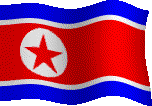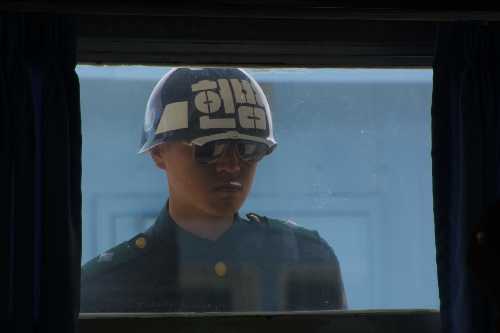 |
||||||
|
Day 3, Thursday May 2, 2002:
After having covered virtually everything Pyongyang had to offer yesterday, we were now on the bus driving 160 (or 190, depending on which map you use) kilometres south towards Kaesong and the DMZ at Panmunjom .
Again we got a good look at the countryside and it hadn't improved much since our first impressions from the train. So many people walking on dusty roads or along trainlines (not afraid of traffic apparently!), ox carts in the fields, a few tractors, women washing clothes in shallow rivers, plenty of red flags everywhere and slogans and pictures of KIS on the larger buildings. Flat bungalows or 4-storey apartment blocks, often crudely built and unpainted.
On the way we stopped at the Sugok Rest House (a motorway station) that spanned both sides of the road. It was quite busy with two more buses of possibly Malaysian or Chinese tourists. The souvenir stand on the south-bound side was making brisk business, fans made of real feathers and cigarettes were especially popular. I looked for a 'Pyongyang' t-shirt, but couldn't see any in my size. I tried all through the week, but to no avail.
We had tea in the tea room overlooking the road. The other groups left shortly after we got there, so we had the place to ourselves. Not much of a view, just a straight, empty road towards the horizon. It was very quiet, but pleasantly so.Kaesong was the capital of Koryo (918-1392), the first unified state on the Korean peninsula. It's widely known for its insam (ginseng).
We went through the Koryo Museum, housed in the old Confucian college, built in the early 11th century. Nice pavilions and a souvenir shop near by. I bought a nice little grey vase with a mountain and flying cranes motif, similar to the originals we saw on display.
Koryo Museum in Kaesong
Then back onto the bus, going into the DMZ at Panmunjom. We were accompanied by soldiers on the way in and photography from the bus was more strictly forbidden than already otherwise. With two soldiers sitting behind you it's easy to comply!
At PanmunjomWe'd get off the bus and a very (very) young soldier showed us on a big map the positions around the border. This area has the world's highest flag tower on the NK side, but the SK one cannot be much shorter. The soldier was happy to pose for photos with us, which many did take advantage of.
We'd then hang about, or more shopping for the insatiable, until we were finally made to walk in single file through a little gate back to the bus, which had driven through a barrier.
I'm not entirely sure on the reasons behind this procedure, but we were by now used to do as we were told. It's quite amazing how compliant we were throughout the week, routing for NK on the Pueblo or when Nick, the tour organizer, showed us the 'The Game Of Their Lives' TV program that he's an associate producer to. It tells the story of the NK football team that took part in the 1966 Football World Cup and famously beat Italy, thus eliminating them from the competition. The NK team reached the quarter finals and no Asian team had ever done better until 2002, when the South Korean team reached the semi final stages.
A British TV team were over the last four years granted unprecedented access to the players and had interviewed them. How we cheered when the NK team won and how we suffered when they lost from a 3-0 lead to go down 3-5 to Portugal in the first knock-out round! You get quite taken in by it all, and of course the Koreans we met were all very nice and polite and likeable, so that we were quite naturally 'on their side'. (The program was shown on BBC 4 in May 2002, but has been sold to other countries and may well be the first program ever to be shown in both North and South Korea in the same version. A small masterpiece in diplomacy!)At the border we got to see the various buildings that make up Panmunjom, for example the Truce Talk Halls, where the armistice talks were held during the Korean War and the hall were the truce was signed (the tables and chairs we sat on were the originals in both). Then the Panmun Pavilion just near the border with its balcony overlooking the buildings on the South Korean side. We didn't see anybody over there other than military personnel (who watched us closely), because the NK side brings its tourists in the morning, the south side in the afternoon.
View towards SK border pavilion
Looking over towards SK soldiersThe NK soldiers were all perfectly amicable, but very businesslike in their attitudes, whereas the SK soldiers over the border were swaggering about the place and without exception wore huge sunglasses. They looked like caricatures. As we sat in the hall that straddles the border, they would look through the window, unsmiling, and look what we were doing. (I read elsewhere that the NK do the same thing when SK bring their tourists, so don't be frightened. It means nothing.)
We did not see any American soldiers.

South Korean soldier looking in
The border itself at this place is just a line of low concrete on the ground, so theoretically defection here is easy, but of course you are so closely watched, one false step and you get shot, probably from both sides at the same time. I walked backwards a bit to have my picture taken with both NK and SK soldiers in the background and inadvertendly stepped off the paved area onto the sand between the huts. A whistle blew immediately and I quickly stepped forward. I hadn't noticed that there was a line painted where the paving ended. Oops, major incident closely avoided! [I had typed 'international incident' here first, but it wouldn't have been, or would it??]
The guide asked us how we felt at seeing this. I'm German and have seen something similar to this before in Berlin, many years ago, but it was never quite such a closed border as this. We could watch each other's TV and phone relatives and everybody knew what was going on on either side. There were diplomatic and private relations on all levels. The differences between NK and SK are far more pronounced and all contact is severed. For example, the NK side has a scrambling device that deflects SK radio and TV signals. This device is never ever switched off, no matter how short they may be on electricity.
The atmosphere at Panmunjom wasn't eery or oppressive, but quietly sad and a bit apprehensive. I looked at the soldiers and half thought, what would happen if one of them were to make a break for the South? What would happen to us, being witnesses to the crime?
Of course nothing did happen. Anybody stationed at such a sensitive spot is probably hardline anyway, plus they'll have families they'd get into trouble.
Besides, the SK soldiers really did look like wanna-be Americans and not like Koreans. The NK argument that they're all American puppets gets some credibility when you see them swaggering along the border.Forgive the ramble, I don't know yet what to make of it.
We then had a big lunch in the Czech and Polish buildings within the DMZ. I was not feeling too bright, so restricted myself to the salad, vegetables and only a couple of bites of the meat and a bit of soup. K said she felt similar yesterday, and it was the first indication that something was going round that eventually would befall more than half the group. Some would suffer more severely than others.
In yet another souvenir shop I saw the hardest working woman in the country. All by herself and dealing with a good 20 foreigners, none of them speaking any Korean. To our credit, it wasn't our group, but a bunch of retching and spitting Chinese that wanted to see this and that and asking prices for everything. I bought some Panmunjom postcards, but got given the ones with Chinese legends, so when I noticed I went back to exchange them for the English ones. It took a while before I got to attract her attention. Poor woman, she must have been looking forward to her free afternoon!
Back to Kaesong and a quick wander through the 'Folk Hotel'. Neat little Korean style houses along a little stream, with a couple of (closed) shops and restaurants amongst them. A huge statue of KIS was visible through the trees on a hill in the distance, and ordinary houses just behind the perimeter wall. Their roofs looked much more ramshackle. We spent about 20 minutes here. Mildly diverting.
Model Village in Kaesong
Back onto the bus to look at the twin tombs of the 31st King of Koryo, Kongmin, who ruled between 1352 and 1374, and his wife. The tombs are about 11km west of Kaesong and were built during the king's lifetime. He was involved in their design and construction took about 7 years. Stone sculptures of tigers and sheep and palace officials surround the tombs. The site is up a number of stairs in a nice scenic spot, but I wasn't well enough to appreciate it all. I just wanted to get back to the hotel and lie down.
Twin tombs of King Kongmin and his queen
When we made our way back to Pyongyang we again stopped at the motorway station. Only the souvenir stall on the northbound side was open, the other side was dead, so they must have been expecting us. How bizarre. How do they spend their days? Every few hours a bus comes along, so all hands on deck for 20 minutes and then back to doing what? I'm surprised we never saw anybody drunk...
One last stop, just before reaching Pyongyang. The Monument to Three Charters for National Reunification (details), which straddles the motorway, is so new (completed in 2001 I think), that none of my guide books mention it. I scribbled down that it is 41.5 metres wide, representing 4 and 15, the great leader's birth date. The two female figures represent NK and SK, reaching out for one another. I was shivering by now and paid little attention.
Monument to Three Charters for National Reunification
Our guide at the Reunification MonumentWhen I got back to the hotel at 7.30 I was in bed within 10 minutes. I was considering a bath, but the water wasn't running hot enough, so I just had a quick shower and drank the hot water from the thermos the maid had luckily just brought to the room. I also opened some of the chocolate I had brought. I was hungry and wanted something 'nice'.
After 5 minutes of television I drifted off to a restless sleep.
for search engines: north korea, holiday, travel, Nordkorea, Nord Korea, travelog, diary, Reisebericht, Arne Eilers, Pyongyang, Panmunjom, dprk, pjongjang, koryo, chosun, urlaub